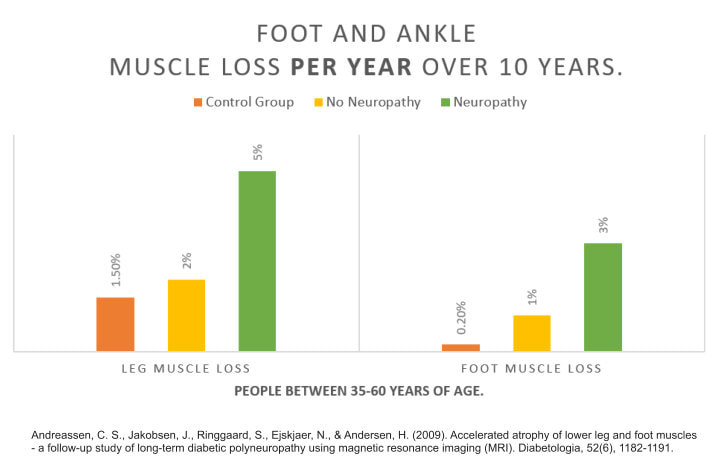|
The understanding of ageing on muscle loss (called sarcopenia) has undergone rapid development over the last 50 years. Although we don't know all the reasons why people lose muscle mass as they age, most of the reasons are probably now known.1 As we age, the muscle loss is typically worse in the hands and feet, the latter causing issues with balance and tripping. Diabetes is known to accelerate the ageing process and the more poorly controlled the diabetes typically the worse the muscle loss.2 To quantify the amount of muscle loss a group of researchers looked at MRIs of the foot and ankle in images that were taken of the same people 10 years apart.3 To further investigate the results they divided the patients up broadly into those that had neuropathy, those that didn't have neuropathy and a healthy control group without any disease. The results can be seen in the following graph: Annual loss of foot and ankle muscle in people aged around 35 - 60 years. Comparing MRIs of patients feet, looking at the same muscles with an approximate 10 year gap in between.
Leg muscles: Neuropathic patients: About 5% of muscle lost each year. Non-neuropathic patients: About 2% loss of muscle each year. Controls: About 1.5% loss of muscle each year. Foot muscles: Neuropathic patients: About 3% of muscle lost per year. Non-neuropathic patients: About 1% lost per year. Controls: About .2% lost per year. Conclusions/interpretation: Muscular atrophy in long-term diabetic neuropathy occurs early in the feet, progresses steadily in the lower legs, relates to severity of neuropathy and leads to weakness at the ankle. Reference
1 Comment
|
AuthorMatt Dilnot is a Podiatrist working in the Eastern Suburbs of Melbourne, Victoria. Archives
May 2020
Categories |



 RSS Feed
RSS Feed